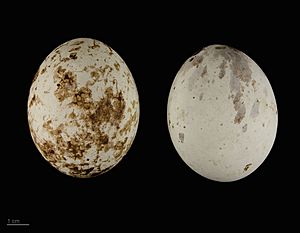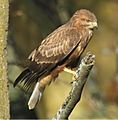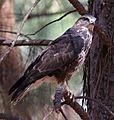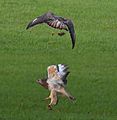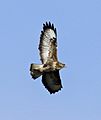Common buzzard facts for kids
Quick facts for kids Common buzzard |
|
|---|---|
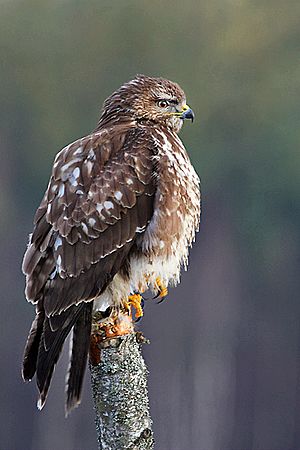 |
|
| Conservation status | |
| Scientific classification | |
| Kingdom: | |
| Class: | |
| Order: | |
| Family: | |
| Genus: | |
| Binomial name | |
| Buteo buteo (Linnaeus, 1758)
|
|
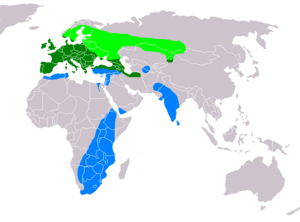 |
|
| Dark green: All-year distribution Light green/blue: Breeding/winter range of Steppe Buzzard. |
|
The common buzzard (Buteo buteo) is a type of bird of prey. These birds are very common across the Old World, which includes most of Europe and parts of Asia. They are about 51 to 57 centimeters long. When their wings are spread out, they can measure between 110 and 150 centimeters (about 48 to 60 inches). Common buzzards can be many different colors, from almost pure white to black. Most often, they are a shade of brown.
Contents
About the Common Buzzard
Common buzzards are strong hunters. They are known for their sharp eyesight and powerful talons. These birds play an important role in their ecosystems. They help control the populations of small animals.
What They Look Like
Common buzzards have wide, rounded wings and a short tail. Their feathers can vary a lot in color. Some are very dark brown, while others are light brown or even creamy white. This wide range of colors can sometimes make them hard to identify. Even with different colors, they all have the same general shape and size.
Where They Live and Hunt
Common buzzards like to build their nests in woodland areas. They prefer forests or woods that are close to open land. This open land is where they do most of their hunting. You might see them flying high in circles, looking for food. They also like to perch on trees or poles, watching for prey.
What They Eat
These birds mainly eat small animals. Their diet includes insects and rodents like mice and voles. They also hunt small birds and eat eggs. Sometimes, they can catch larger prey. This might include adult grouse or even rabbits. You might even see them walking in recently ploughed fields. They do this to find worms and insects that have been brought to the surface.
Family Life
Common buzzards usually do not fly in large flocks. However, you might see a few of them together. This can happen during their migration journeys. It also happens in places where there is a lot of good food. Once a pair of buzzards finds each other, they usually stay together for their whole lives. They work together to build nests and raise their young.
Different Kinds of Buzzards
Scientists have described many different types of common buzzards. These are called subspecies. Some experts believe there are around 11 valid subspecies. Other experts think there are fewer, maybe around seven. These different types might have slightly different colors or live in different parts of the world.
Images for kids
-
Juvenile forest buzzards of Africa are extremely easy to mistake for juvenile common buzzards of the steppe race that come to winter in Africa.
-
A steppe buzzard migrating through Israel, where buzzards have one of the largest raptor migrations in the world.
-
A buzzard with a freshly caught rodent, likely a vole.
-
A crow mobs a buzzard. Buzzards will readily prey on crows, especially their fledglings.
-
A buzzard that caught a large Green whip snake but was flushed from its catch.
-
A juvenile white-tailed eagle being mobbed by a pair of common buzzards over the Isle of Canna, as the eagle will sometimes prey on the buzzard.
-
The remains of a common buzzard that was preyed on by a Eurasian eagle-owl.
-
A pair of common buzzards in Scotland.
-
A territorial dogfight between three buzzards in the Azores.
-
The much plainer egg of the common buzzard contrasted with that of the European honey buzzard.
-
A wintering steppe buzzard in South Africa.
See also
 In Spanish: Busardo ratonero para niños
In Spanish: Busardo ratonero para niños



